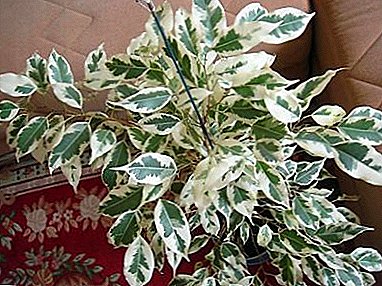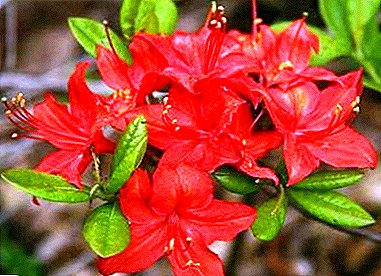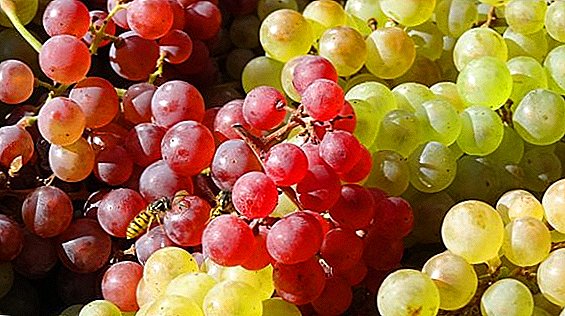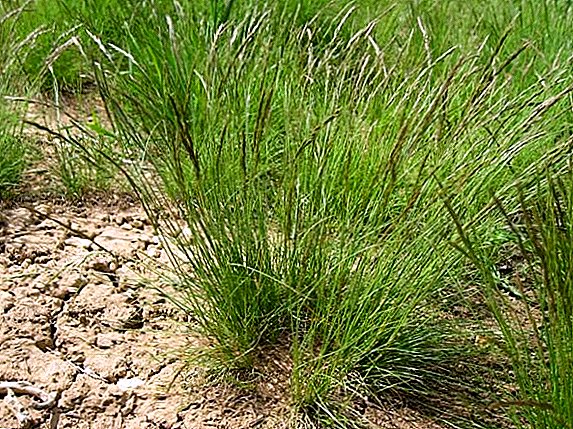
Evergreen ficuses are a huge genus that counts more than 800 speciesmainly from Africa and Asia.
Suitable for indoor conditions types of figs are grown for decorative leaves.
One of the most popular among them is the Benjamin Ficus, as it is excellently suited for both modern housing and office space.
The latter in turn has its own subspecies. And one of them - Benjamin Ficus variegated.
The origin of the plant
Ficus - Mulberry family plant (Moraceae)which, incidentally, includes a fig tree with edible fruits.
Homeland plants - Eastern India, but the information in this regard is ambiguous.
The homeland of the ficus is called Southeast Asia and Northern Australia. It is in nature a tall tree with a wide crown and falling branches.
However, in indoor conditions, this weeping tree rarely exceeds 2.4 m high although there are instances up to 3 m
Home care
Benjamin Ficus variegated whimsical than their fellows.
It grows quite quickly, but requires a lot of light.
It can even live in a spacious, well-lit kitchen.
It is considered easy to grow.
 If a new tenant named Ficus Benjamin with motley leaves has appeared in your house, then immediately determine his place of permanent residence.
If a new tenant named Ficus Benjamin with motley leaves has appeared in your house, then immediately determine his place of permanent residence.
He really does not like to change the situation!
It is necessary to follow the following rules for its habitat:
- maximum lighting;
- protection from direct sunlight;
- away from radiators;
- lack of drafts.
From the first day you can spray the plant up to 2 times a day.
Important: It is possible to replant only after a small adaptation, somewhere in about three weeks.
Watering
Both in summer and in winter it needs spraying. It places high demands on the degree of humidity.
Therefore, in the winter you need to keep away from radiators and apply daily spraying.
For irrigation using soft settled warm water.
Summer requires abundant watering. Approximately twice a week.
However, we must ensure that the soil is slightly dried.
Important: Roots should not be soaked in water.
In winter, watering is moderate, about once every ten days.
A lot of moisture in the winter they do not need. From its excess, the lower leaves will fall off, and the plant will lose its decorative appearance.
Tip: It is recommended to apply liquid organic or mineral fertilizers together with irrigation every two weeks.
Bloom
A fact little known, but indisputable: the flower of ficus is an inflorescence called syconia.
It looks like berries rather than flowers.
True, in room conditions, they do not bloom. You can see it only in the greenhouse.
Crown formation
 There are two options for crown molding: bush and standard tree.
There are two options for crown molding: bush and standard tree.
From this ficus can grow bonsai.
If evenly cut young shoots, you get a bush.
If you remove the side shoots, leaving only one, then you will get a standard tree.
To get a well-branched tree, you need to prune the top when the plant reaches 40 cm height.
This will lead to active growth of the lateral branches.
The tops of new shoots can pinch in the spring and autumn, including in adult specimens - this will help the unsightly bush to turn into a lush plant.
In addition, in order to form the crown evenly, from time to time it is necessary to turn the pot with different sides to the light.
Soil and soil
For planting should use fertile soil, preferably neutral, but it is possible and slightly acidic.
It is imperative to use good drainage (clay on the bottom of the pot).
The composition of the soil can be taken one by one in this version: peat, sheet, sod land and sand.
Sand can be used over the ground in a pot.
To reduce the acidity of the soil, you can add charcoal (ash) to the soil mixture.
Planting and transplanting
Young ficuses (up to 3-4 years) transplanted every year.
Although some flower growers are advised to do this every second spring, that is, once every two years.
It can be argued that the plant does not like frequent transplants.
The pot is chosen such that its diameter is half the size of the crown.
When the plant gets too big, and the diameter of the pot will reach 30 cm it is possible to renew the land without transplanting the plant itself.
For this top layer of soil (about 3 cm) removed and updated.
Fertilizer can be added to the soil mix (about 20% of replaceable soil).
A photo
In the photo ficus "variegated":





Breeding
Propagated by cutting, usually in spring.
Composition of the land: sand and peat (1: 1) or sand with obligatory covering by polyethylene to create conditions like in a greenhouse.
Rooting in water is possible, but the period is long, about a month.
Rooted cuttings are planted in pots with a diameter of about 10 cm with the ground (from 3 parts of turf and 1 part of peat) with the addition of a small amount of river sand.
Recommended cover with polyethylene for several days to create greenhouse conditions
Reproduction by seeds is possible. Sown in a small greenhouse with the ground as for grafting. Dive is carried out after the growth of the first leaf, followed by transplanting into a small pot. (diameter up to 7 cm).
Temperature
Variegated forms belong to the thermophilic. If ficus temperature comfort is in summer from 18 to 23 ° С, and in winter - from 16 ° С, then for variegated stands it is worth orienting a few degrees higher.
Lighting
 With good lighting variegated forms have a brighter color.
With good lighting variegated forms have a brighter color.
However, direct sunlight is harmful to the plant.
You can put a pot with a ficus near the south window, but at a distance of about a meter.
In winter, it is advisable to use special fitolamps for additional lighting, so that the plant does not shed its leaves.
Benefit and harm
Ficus helps to clean the air of toxins, as well as increase the oxygen content in the room.
It is poisonous to pets.
Milky juice can cause allergies, irritation and itching. Rinse the infected area well under running water.
Scientific name
List all varieties of Ficus Benjamina impossible. Their huge variety.
The general in their appearance:
- Small leaves.
- The tip of the leaf is very elongated and looks like a sting.
The most common representatives Ficus benjamina with variegated forms can be called Starlight, veriegata, Kinkye, Nikole.
Diseases and pests

The cause of leaf fall may be:
- unlimited watering;
- insufficient watering;
- cold air during ventilation;
- hot air flow from central heating radiators during winter time;
- low water temperature used for spraying
- lack of light;
- changing customary conditions of detention.
When overwetting the soil, small yellow spots and bumps may appear on the leaves.
Dry shriveled leaves are a sign that there is insufficient air humidity in the room.
The yellow edges of the leaves indicate a lack of plant nutrition.
Diversity can disappear with an insufficient amount of light and a large amount of nitrogen in the soil.
Sickly rare.
Major pests:
- mealybug;
- spider mite;
- schitovka.
The ficus so familiar to us (this name is familiar even to people far from floriculture!) Is considered to be a rather unassuming and undemanding indoor plant.
The florists who are well-versed in feng shui argue that the ficus is simply necessary in the office of any manager, since it contributes to the development of enthusiasm and the determination of priorities.












